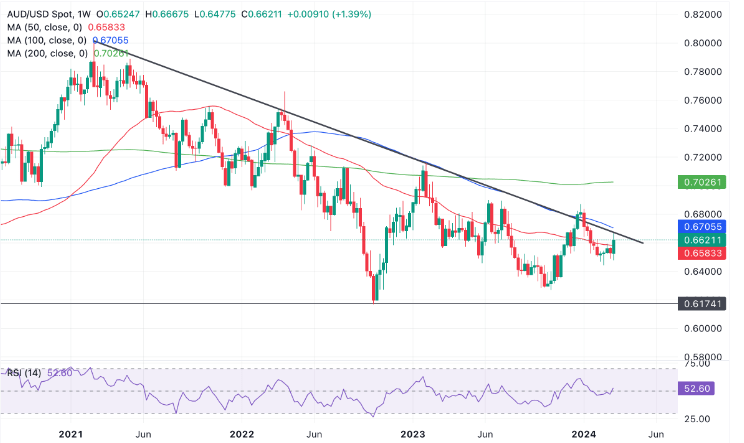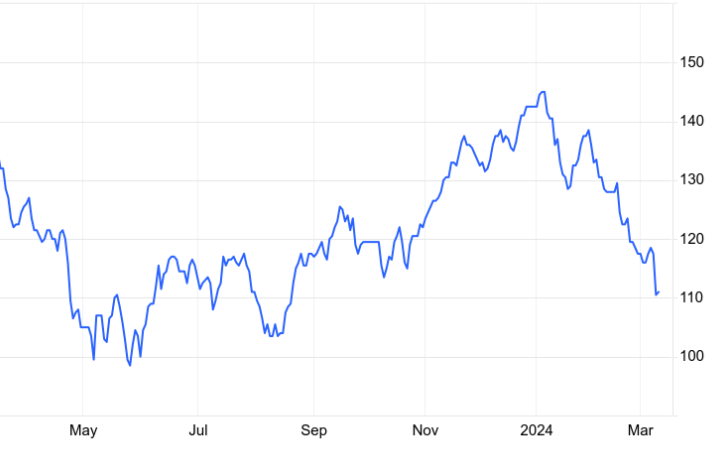- As markets maintain expectations of a Federal Reserve rate cut in June, the AUD/USD pair edges higher.
- In contrast, the Reserve Bank of Australia (RBA) is adopting a more hawkish stance, hinting at the possibility of rate increases.
- However, the decline in iron ore prices, exacerbated by a slump in China’s property sector, weighs on the AUD/USD pair.
During Wednesday’s US session, AUD/USD is hovering in the lower 0.6600s, showing a slight increase of two tenths of a percent for the day. Market sentiment leans towards expectations of a Federal Reserve (Fed) interest rate cut in June, despite resilient inflation figures. This anticipation of lower interest rates weighs on the USD, as it implies reduced foreign capital inflows. In contrast, the Reserve Bank of Australia (RBA) may be inclined towards a rate hike.
Technically, AUD/USD has encountered resistance at a significant level formed by a long-term trendline, resulting in a pause in its upward momentum. The overall outlook remains bearish, reflecting the pair’s sustained downtrend characterized by lower highs and lower lows.

Despite recent gains, the mood music around the Australian Dollar remains negative due mainly to the steep fall in price of Australia’s largest export commodity, Iron Ore, which has dropped by over 20% since the start of 2024.

The decline in Iron Ore prices has been primarily fueled by reduced demand from China, its largest export partner. China’s diminished need for iron stems from its efforts to address challenges within its struggling property sector, leading to decreased steel production.
In contrast to previous economic downturns where the Chinese government intervened to stabilize the economy, this time, it has refrained from providing a bailout to the indebted property industry. During a recent meeting of the Chinese National People’s Congress, the government signaled its intent to hold property magnates accountable for the market’s downturn, rather than offering financial support.
Minister of Housing and Urban-Rural Development Ni Hong emphasized the government’s commitment to investigating and punishing those responsible for actions detrimental to public interests. This stance suggests a shift towards accountability and discipline within the property sector.
Such developments cast a shadow over future Iron Ore prices and could adversely affect the Australian Dollar.
Reserve Bank of Australia split on interest rates
While the Federal Reserve is leaning towards a consensus for a potential interest rate cut in June, the Reserve Bank of Australia (RBA) is taking a different stance, hinting at the possibility of raising rates beyond their current level of 4.35%. Despite a slight decline in inflation from 5.4% to 4.1% in the fourth quarter of 2023, Australia’s inflation remains significantly above the RBA’s target range of 2%-3%.
RBA Governor Michelle Bullock recently emphasized that Australia’s inflation is primarily driven by domestic factors, particularly robust labor market conditions and increasing wage inflation. This suggests that inflationary pressures in Australia are more persistent compared to other countries, indicating a lengthier period before it returns to the target range. Bullock hinted that the RBA might consider raising interest rates to address inflation concerns, with projections suggesting this may not occur until 2026.
Former RBA Governor Philip Lowe echoed similar sentiments, acknowledging the two-way risk associated with interest rates. He supported Bullock’s warning about the potential need for higher interest rates.
The divergence in policy stances between the two central banks implies a potential weakening of the US Dollar against the Australian Dollar. This could offset some of the currency’s vulnerabilities stemming from reduced demand for Australian Iron Ore.
Downtrend to continue?
After a brief rebound, AUD/USD encountered resistance at a significant trendline, suggesting a potential continuation of its long-standing downtrend.
A decisive break below the October 2023 swing low of 0.6442 would confirm the bearish sentiment, likely leading to further downside movement towards the October 2022 lows around 0.6170.
Conversely, a breakout above the December 2023 high of 0.6871 would signal a potential reversal in the long-term trend, implying brighter prospects for the Australian Dollar in the foreseeable future.
